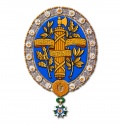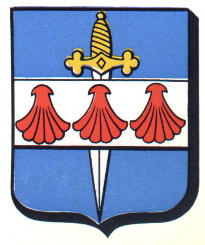Marange-Silvange: Difference between revisions
Jump to navigation
Jump to search
Knorrepoes (talk | contribs) m (Text replacement - "Literature : " to "'''Literature''': ") Tags: Mobile edit Mobile web edit |
Knorrepoes (talk | contribs) m (Text replacement - "↵{{media}}" to " {{fr1}} {{media1}}") |
||
| Line 23: | Line 23: | ||
The arms are derived from the arms of the Travault family, Lords of Marange in the 16th and 17<sup>th</sup> century. The sword is a symbol of St. Paul and refers to the history of Silvange, formerly a possession of the St. Paul Abbey in Verdun. | The arms are derived from the arms of the Travault family, Lords of Marange in the 16th and 17<sup>th</sup> century. The sword is a symbol of St. Paul and refers to the history of Silvange, formerly a possession of the St. Paul Abbey in Verdun. | ||
{{ | {{fr1}} | ||
{{media1}} | |||
[[Civic Heraldry Literature - France|'''Literature''']]: Haefeli, 1959 | [[Civic Heraldry Literature - France|'''Literature''']]: Haefeli, 1959 | ||
Revision as of 13:00, 26 December 2022
French heraldry portal
This page is part of the French heraldry portal |
Heraldry of the World |
|
French heraldry:
Overseas territories:
|
Selected collector's items from France:
|
MARANGE-SILVANGE
Département : Moselle
| French |
D'azur à l'épée basse d'argent garnie d'or; à la fasce d'argent chargée de trois coquilles de gueules brochant sur l'épée. |
| English | No blazon/translation known. Please click here to send your (heraldic !) blazon or translation |
Origin/meaning
The arms were officially adopted on May 4, 1950.
The arms are derived from the arms of the Travault family, Lords of Marange in the 16th and 17th century. The sword is a symbol of St. Paul and refers to the history of Silvange, formerly a possession of the St. Paul Abbey in Verdun.
Literature: Haefeli, 1959


